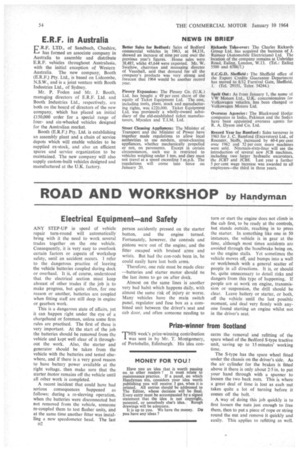ROAD AND WORKSHOP by Handyman
Page 56

If you've noticed an error in this article please click here to report it so we can fix it.
Electrical Equipment and Safety
ANY STEP-UP in speed of vehicle repair turn-round will automatically bring with it the need to work several trades together on the one vehicle. Consequently, it is very easy to overlook certain factors or aspects of workshop safety, until an accident occurs. I refer to the dangerous practice of leaving the vehicle batteries coupled during dock or overhaul. It ii, of course, understood that the electrical section must keep abreast of other trades if the job is to make progress, but quite often, for one reason or another, batteries are coupled when fitting staff are still deep in engine or gearbox work.
This is a dangerous state of affairs, yet it can happen right under the eye of a chargehand or foreman, unless some firm rules are practised. The first of these is very important. At the start of the job the batteries should be removed from the vehicle and kept well clear of it throughout the work. Also, the starter and generator should be taken from the vehicle with the batteries and tested elsewhere, and if there is a very good reason to have battery power available at the right voltage, then make sure that the starter Motor remains off the vehicle until all other work is completed.
A recent incident that could have had serious consequences happened as follows: during a re-sleeving operation, when the batteries were disconnected but not removed from the vehicle, someone re-coupled them to test flasher units, and at the same time another fitter was installing a new speedometer head. The last
D2
person accidently pressed on the starter button, and the engine turned. Fortunately, however, the conrods and pistons were out of the engine, and the fitter escaped with bruised arms and wrists. But had the con-rods been in, he could easily have lost both arms.
Therefore, one rule must be made clear —batteries and starter motor should be the last items to go on after dock.
Almost on the same lines is another very bad habit which happens daily, with almost the same risk of injury or worse. Many vehicles have the main switch panel, regulator and fuse box as a combined unit between the driver's seat and cab door, and often someone needing to
turn or start the engine does not climb in the cab first, to he ready at the controls, but stands outside, reaching in to press the starter. In something like one in 50 instances, the vehicle is in gear at the time, although most times accidents are avoided through the 'handbrake being on, so the engine stalls. Yet sometimes the vehicle moves off, and bumps into a wall or workbench with a general scatter of people in all directions. It is, or should be, quite unnecessary to detail risks and dangers from this type of happening. If people are at work on engine, transmission or -suspension, the drill should be clear. Leave battery or starter, or both, off the vehicle until the last possible moment, and deal very firmly with anyone found starting an engine whilst not in the driver's seat.
























































































































